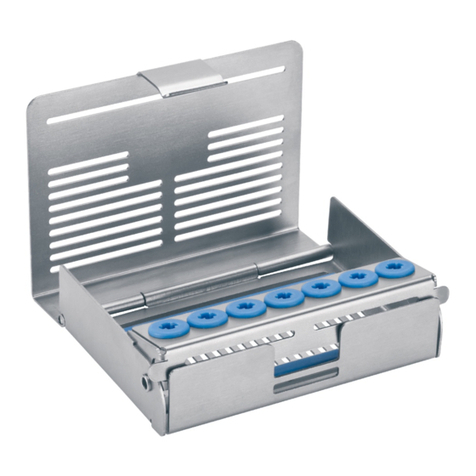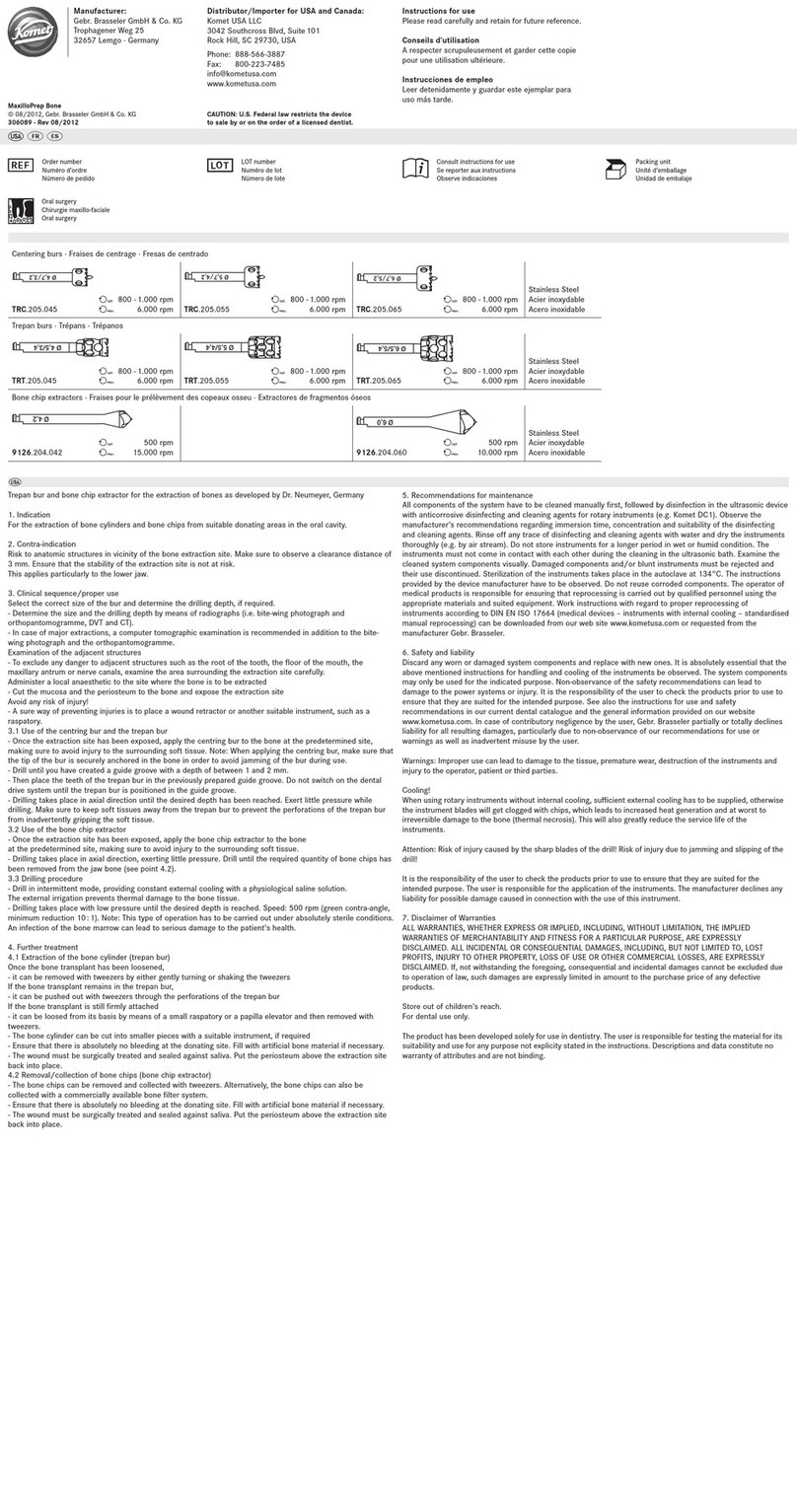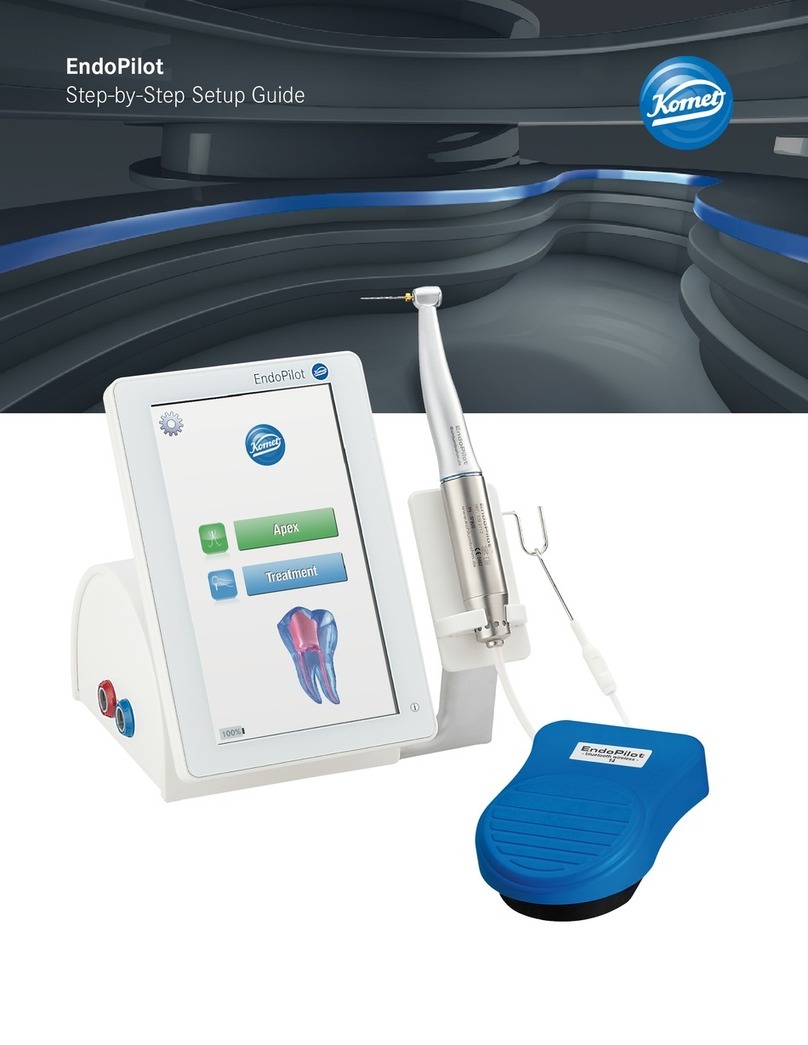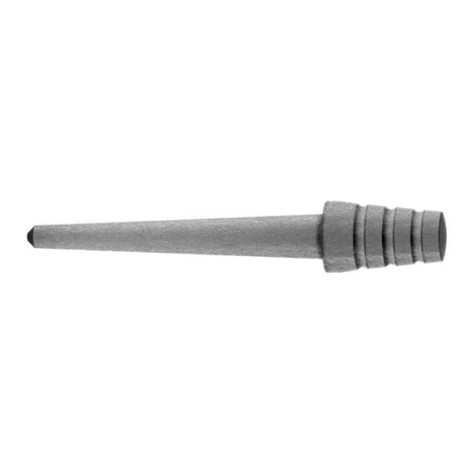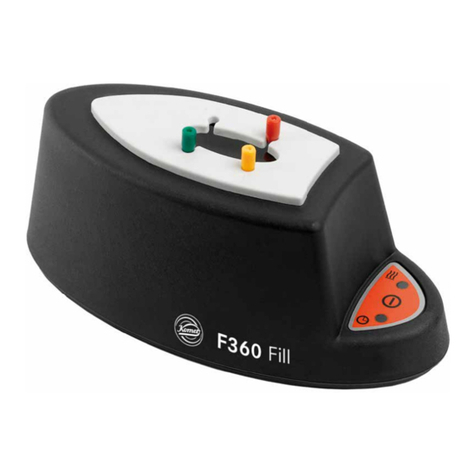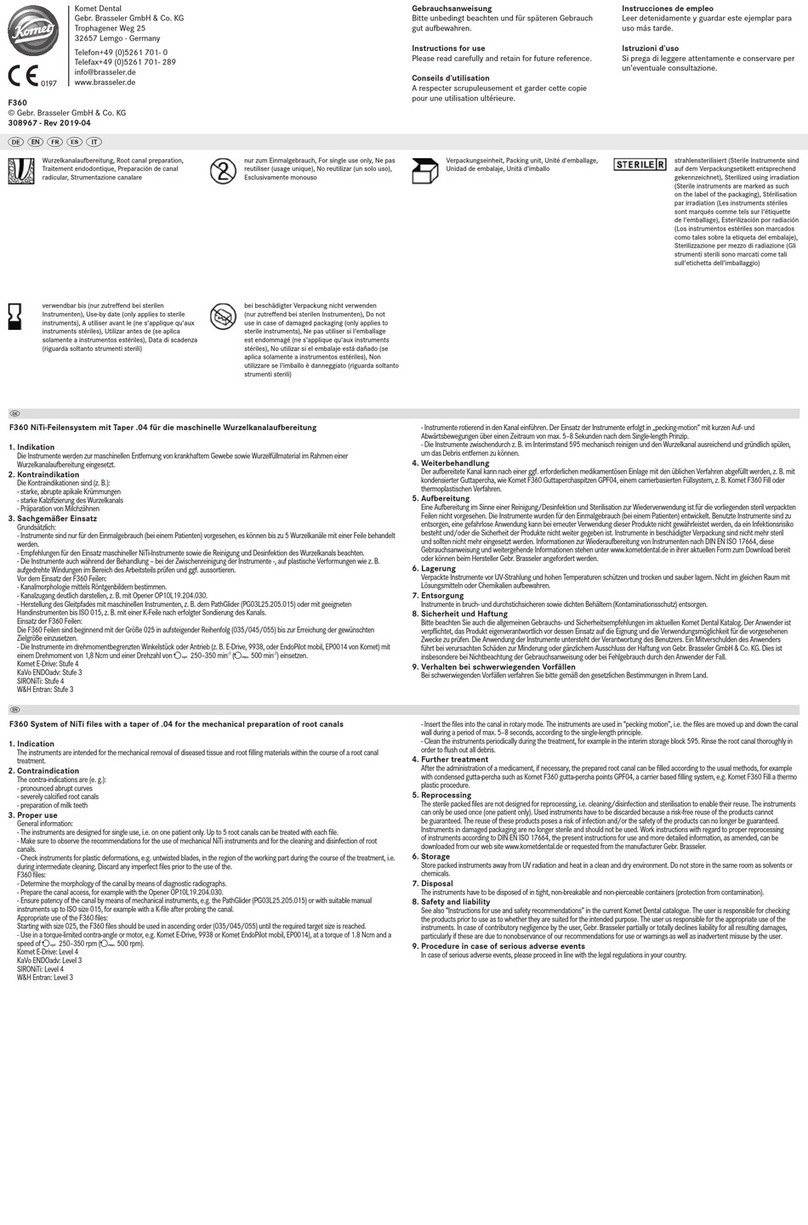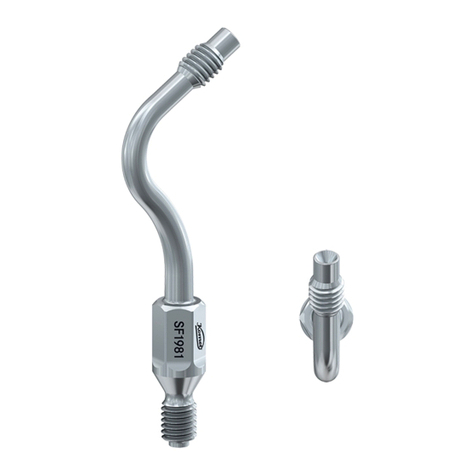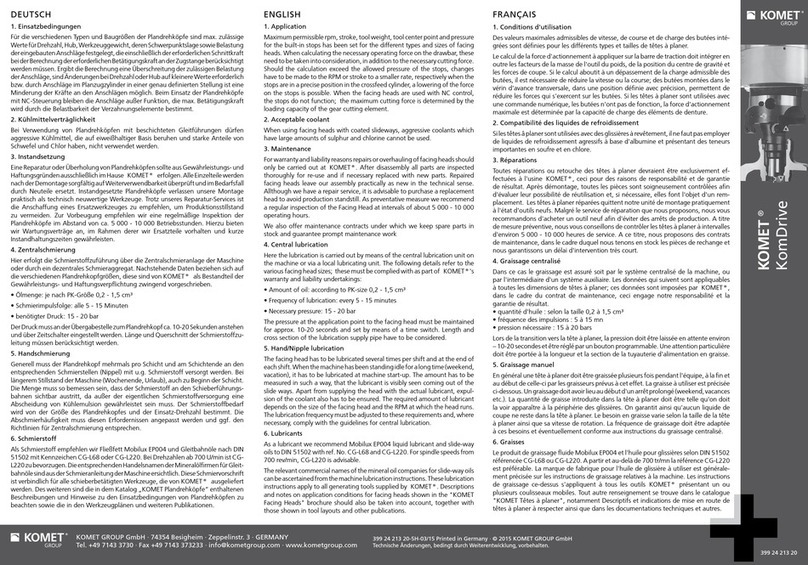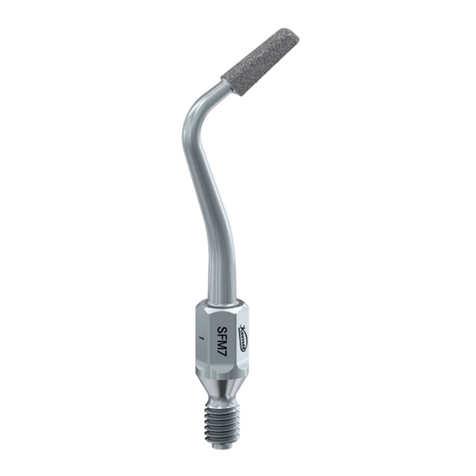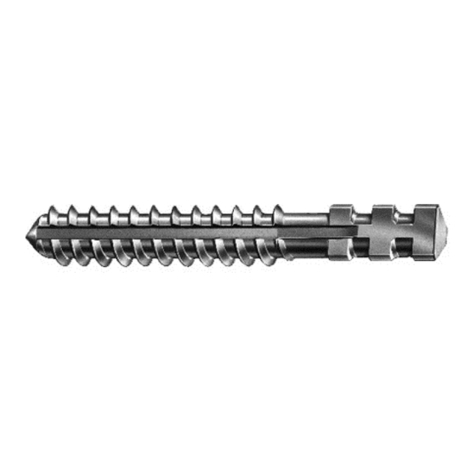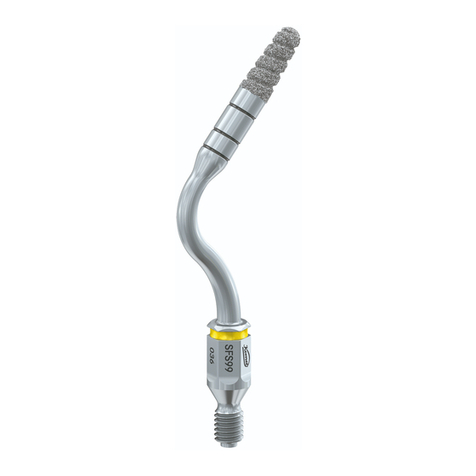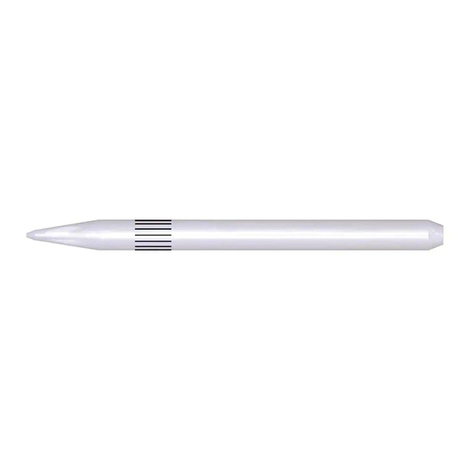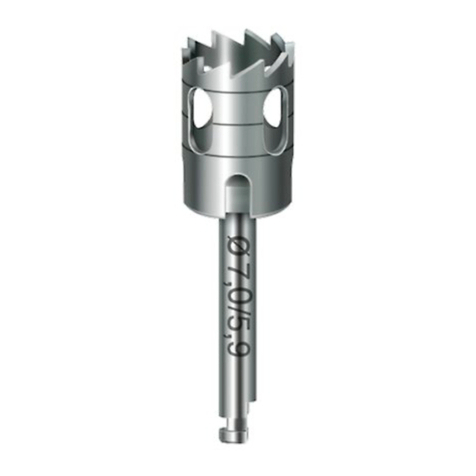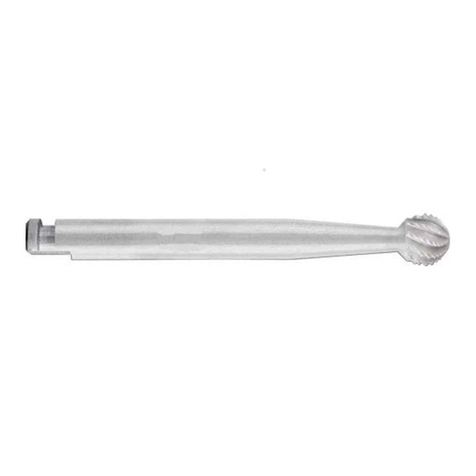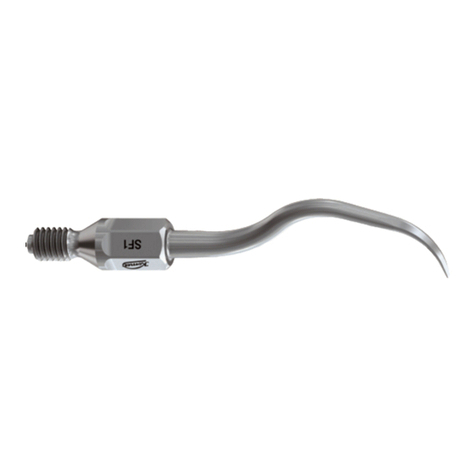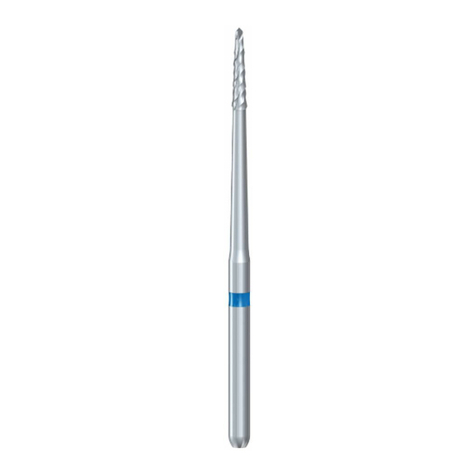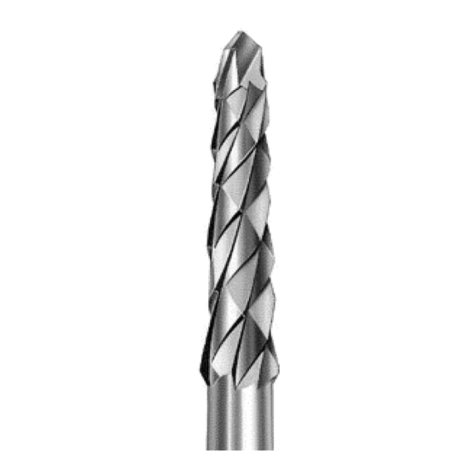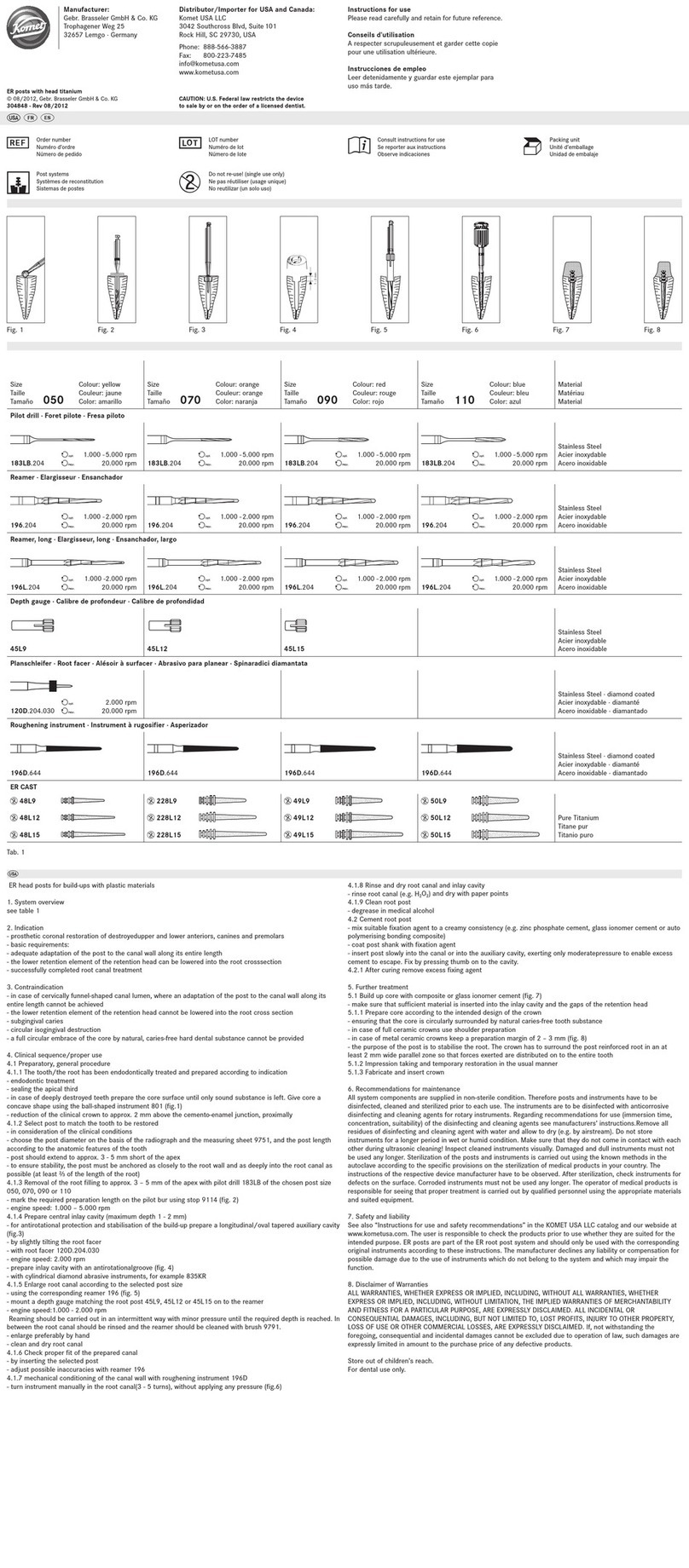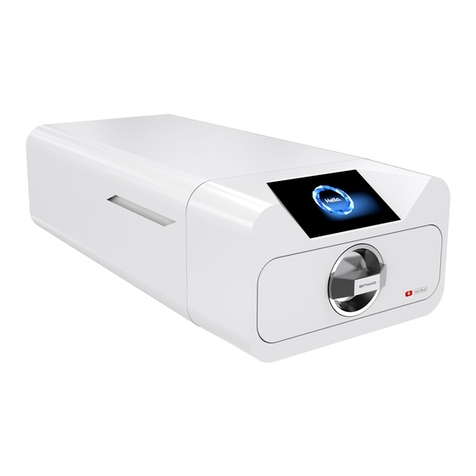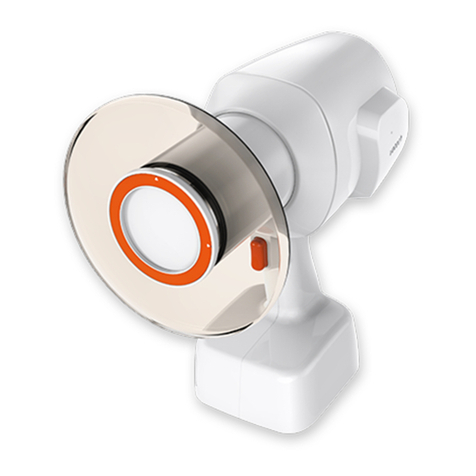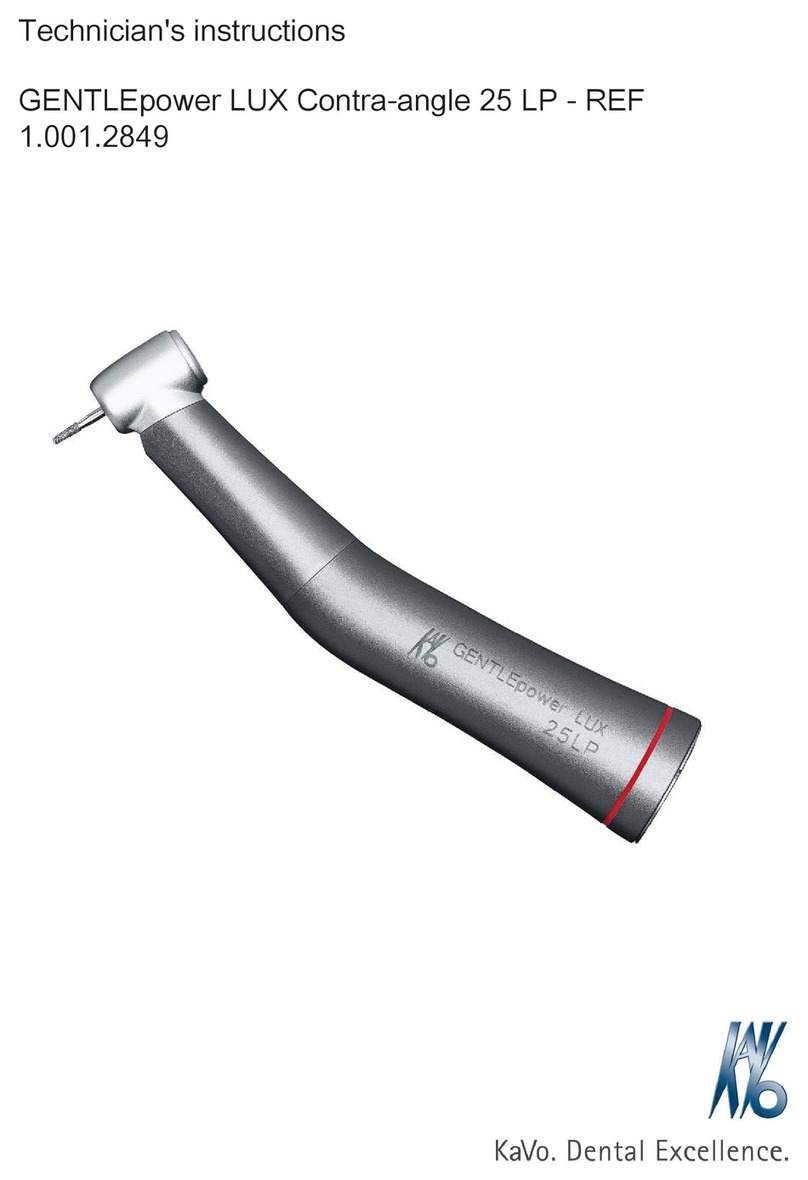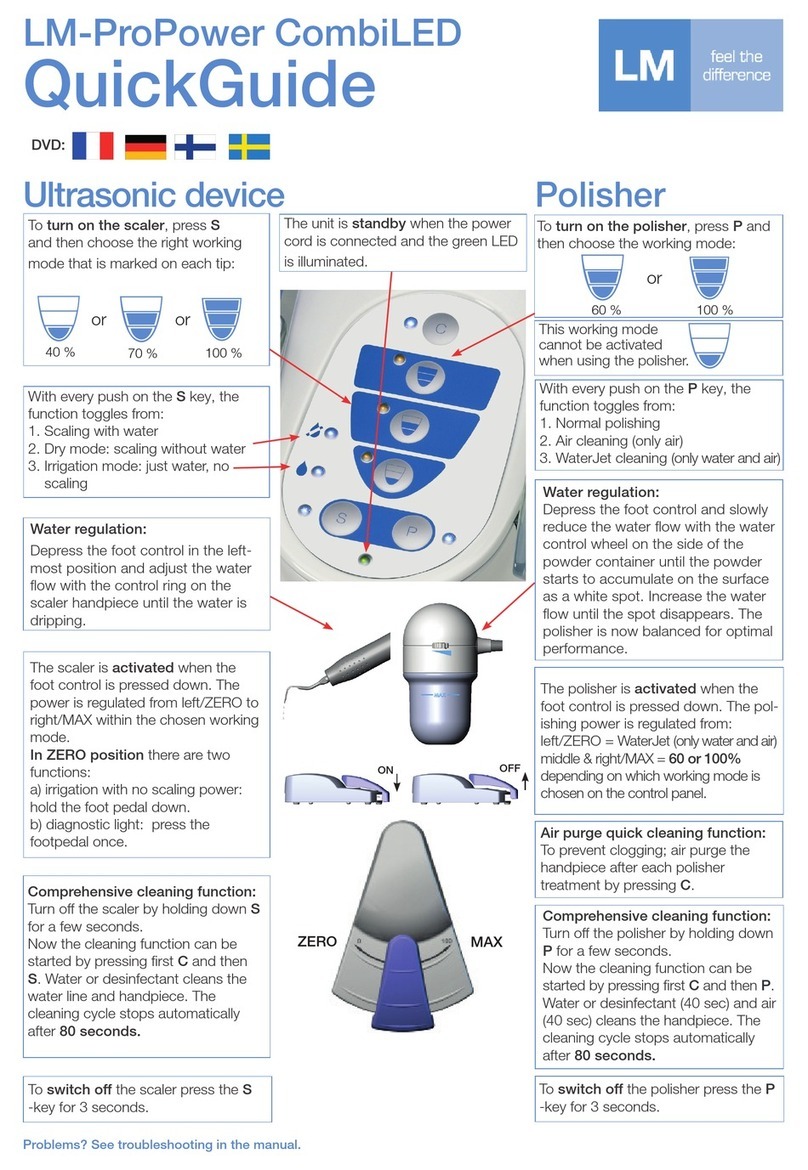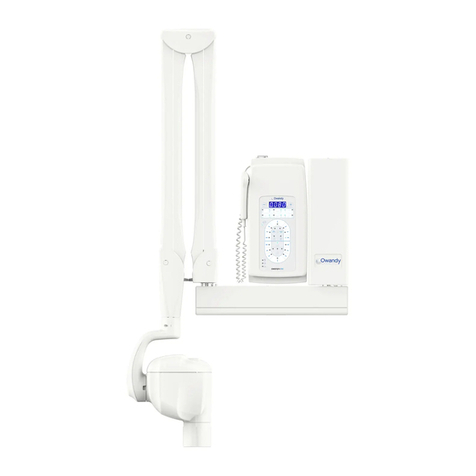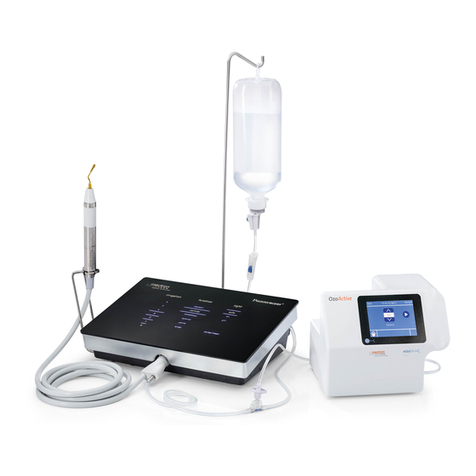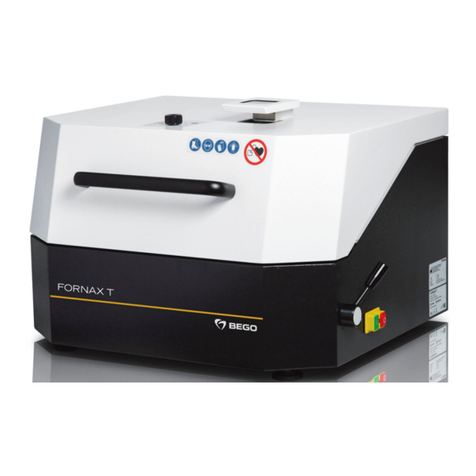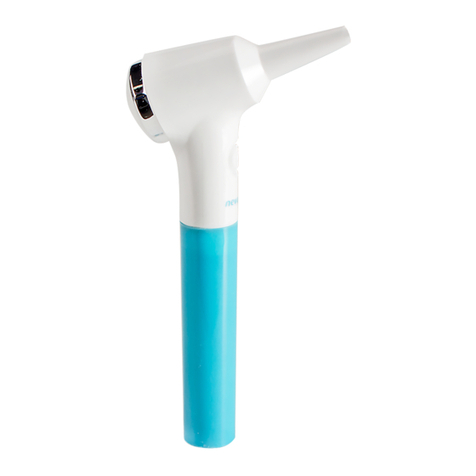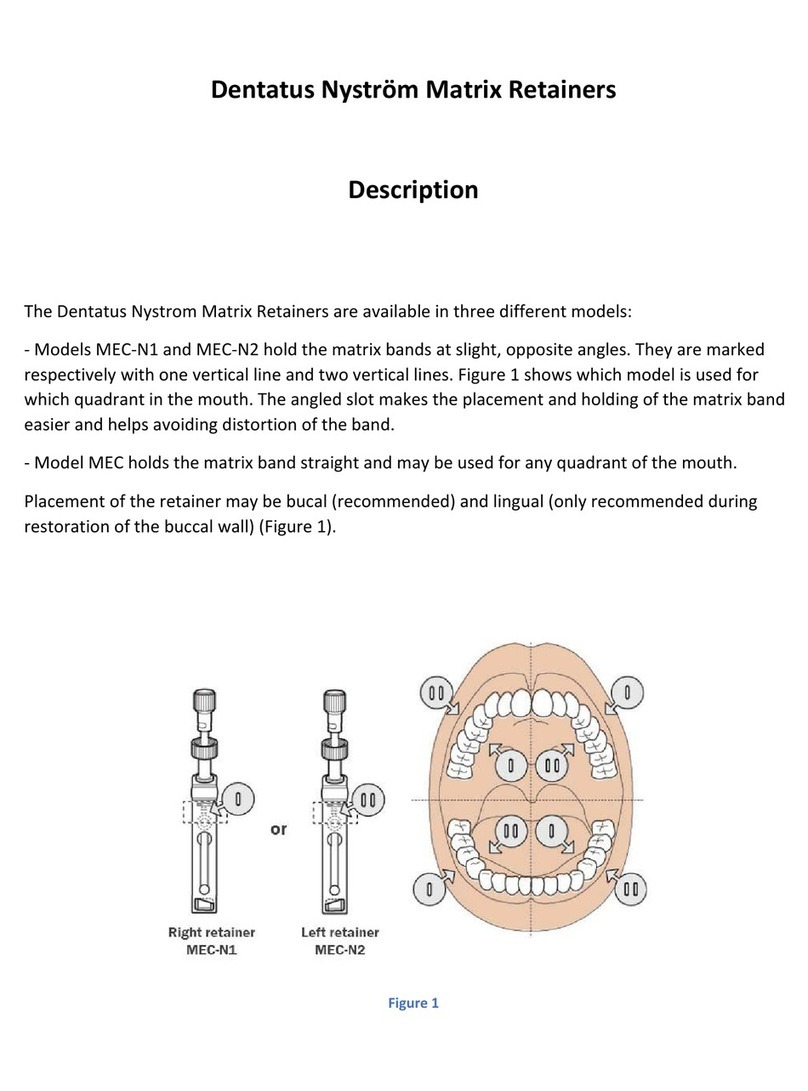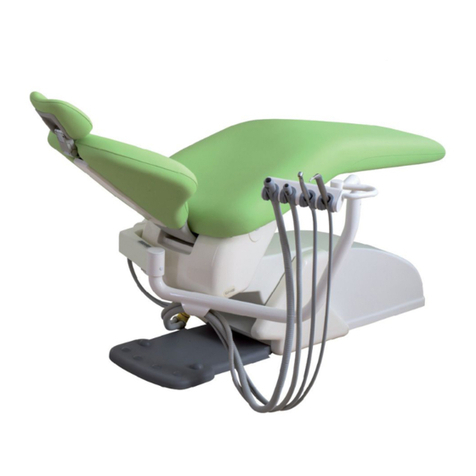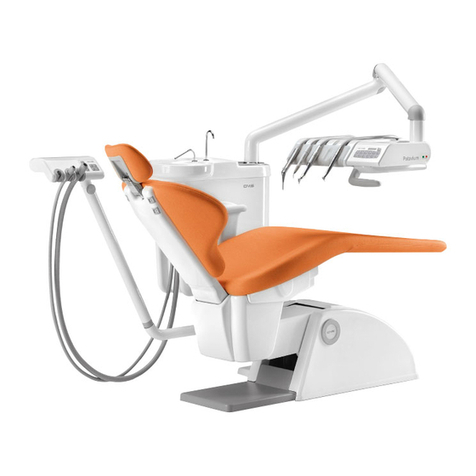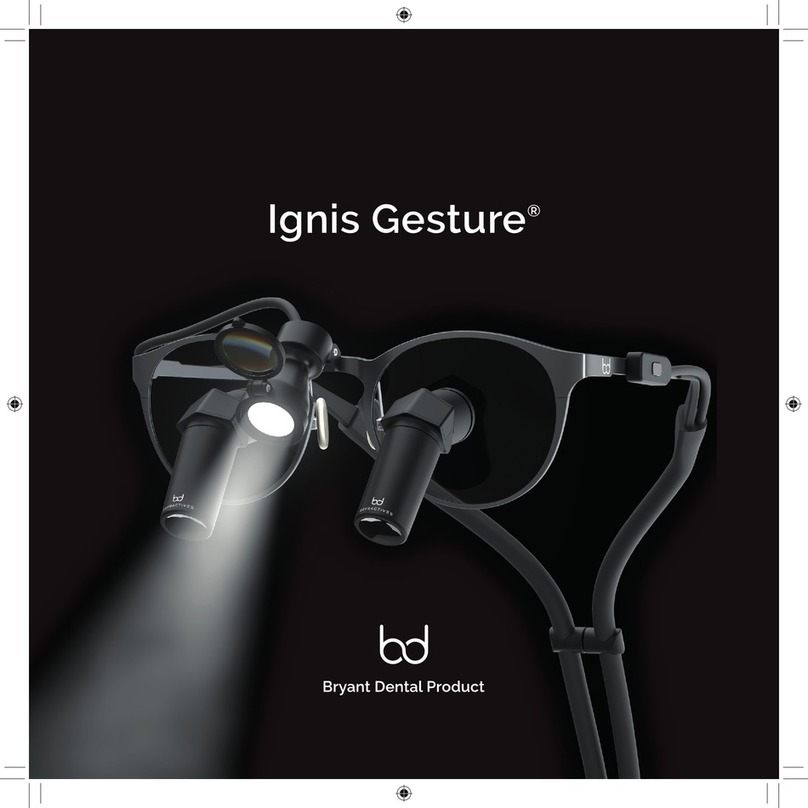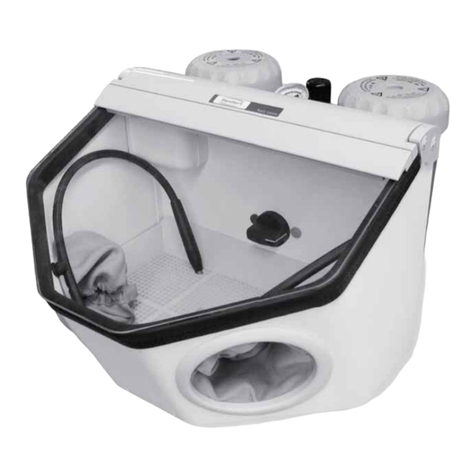
ê
Tenons radiculaires ER C-Post®pour la reconstitution préprothétique
1. Eléments du système
voir tableau 1
2. Indications
- La substance dentaire saine doit pouvoir être enveloppée circulairement.
2.1 Stabilisation préprothétique des dents-pilier dévitalisées avec couronne pratiquement intacte (Fig. 1).
(Dégrée de délabrement 0 - 10 %)
2.2 Reconstitution préprothétique des dents-pilier dévitalisées avec couronne partiellement délabrée, procédé
direct avec matériaux plastiques (Fig. 2). (Dégrée de délabrement 10 - 70 %)
2.3 Reconstitution préprothétique des dents-pilier dévitalisées avec couronne détruite, procédé indirect avec
matériaux céramiques (Fig. 3). (Dégrée de délabrement 70 - 100 %)
3. Contre-indications
- Dents dont la couronne est fortement délabrée, sans substance dentaire supragingivale.
4. Déroulement du traitement général préparatoire
4.1 La dent et la racine ont été préparées conformément à l’indication et ont subi un traitement endodontique.
4.2 Choisir la taille du C-Post®
- A l’aide de la radiographie choisir le diamètre du tenon selon l’anatomie de la dent.
4.3 Retirer l’obturation radiculaire jusqu’à environ 4 mm de l’apex avec le foret pilote 183LB de la taille du tenon
choisi 050, 070, 090 ou 110.
- Marquer avec le calibre de profondeur 74L12 la longueur nécessaire de la préparation sur le foret pilote.
- Vitesse de rotation :1.000 - 5.000 t/min.
4.4 Préparer le canal radiculaire adapté au C-Post®choisi
- Utiliser l’élargisseur 196; si la couronne clinique est valable, utiliser l’élargisseur 196L.
- Marquer avec le calibre de profondeur 74L12 la longueur nécessaire de la préparation sur l’élargisseur.
- Vitesse de rotation :1.000 - 2.000 t/min.
4.5 Insérer le tenon choisi pour contrôler l’ajustement.
5. Procédure dépendant de l’indication
5.1 Stabilisation préprothétique (indication 2.1)
5.1.1 Rugosification mécanique de la paroi canalaire avec l’instrument diamanté 196D.
- Tourner l’instrument dans le canal radiculaire manuellement 2- 3 fois sans pression.
5.1.2 Rincer et sécher le canal.
5.1.3 Nettoyer la surface du tenon
- Nettoyage avec de l’alcool médical
- Sabler encore une fois avec de l’oxyde d’aluminium (50µm)
5.1.4 Utiliser la technique adhésive pour cimenter le tenon
- Conditionnement chimique de la dentine avec un agent adhésif (p.ex. ED Primer®, Kuraray)
- Recouvrir le C-Post®avec un composite autopolymérisant (p.ex. Panavia®F2.0, Kuraray).
- Insérer lentement le C-Post®dans le canal radiculaire et le fixer avec peu de pression du pouce.
- Polymériser le composite et si nécessaire retirer l’excès d’adhésif.
5.1.5 Compléter la préparation définitive.
5.2 Reconstitution plastique (indication 2.2)
5.2.1 Rugosification mécanique de la paroi canalaire avec l’instrument diamanté 196D.
- Tourner l’instrument dans le canal radiculaire manuellement 2-3 fois sans pression.
5.2.2. Rincer et sécher le canal.
5.2.3 Nettoyer la surface du tenon
- Nettoyage avec de l’alcool médical
- Sabler encore une fois avec de l’oxyde d’aluminium (50µm)
5.2.4 Utiliser la technique adhésive pour cimenter le tenon
- Conditionnement chimique de la dentine avec un agent adhésif (p.ex. ED Primer®, Kuraray).
- Recouvrir le C-Post®avec un composite autopolymérisant (p.ex. Panavia®F2.0, Kuraray).
- Insérer lentement le C-Post®dans le canal radiculaire et le fixer avec peu de pression du pouce.
5.2.5 Adaptation de la reconstitution plastique (p.ex. Clearfil PhotoCore®, Kuraray).
5.2.6 Polymériser et terminer la préparation définitive.
5.3 Reconstitution céramique (indication 2.3)
5.3.1 Préparation de la cavité inlay centrale (profondeur maximale 1 mm)
- Quand le diamètre de la racine est suffisant, avec la fraise à surfacer 120D.204.030
- Vitesse de rotation : 2.000 t/min.
- ou avec des instruments diamantés cylindriques p.ex. 835KR.
5.3.2 Empreinte de la préparation provisoire avec tenon inséré pour la préparation de la reconstitution
céramique dans le laboratoire (p.ex. avec Permadyne®, Espe).
5.3.3 Pendant les travaux dans le laboratoire, approvisionnement temporaire avec les tenons ER TMP.
5.3.4 Production de la reconstitution céramique en deux pièces dans le laboratoire (p.ex. en InCeram-Aluminia®,
In-Ceram-Spinell®, Vita ou IPS-Empress Cosmo®, Ivoclar).
5.3.5 Livraison de la reconstitution céramique adhérée et sablée dans le laboratoire.
5.3.6 Retirer l’approvisionnement temporaire et nettoyer le canal.
5.3.7 Rugosification mécanique de la paroi canalaire avec l’instrument diamanté 196D.
- Tourner l’instrument dans le canal radiculaire manuellement 2-3 fois sans pression.
5.3.8 Rincer et sécher le canal.
5.3.9 Utiliser la technique adhésive pour cimenter le tenon
- Conditionnement chimique de la dentine avec un agent adhésif (p.ex. ED Primer®, Kuraray).
- Recouvrir la partie du C-Post®avec un composite autopolymérisant (p.ex. Panavia®F2.0, Kuraray).
- Insérer lentement le C-Post®dans le canal radiculaire et le fixer avec peu de pression du pouce.
5.3.10 Polymériser et terminer la préparation définitive.
6. Traitement ultérieur
6.1 Observer les principes suivants pour la préparation définitive :
- Veiller à ce que la couronne couvre le moignon circulairement.
- Pour des couronnes entièrement en céramique, réaliser une limite de préparation du type épaulement.
- Le tenon sert à stabiliser la racine. La couronne doit couvrir la racine avec le tenon dans une zone parallèle
d’au moins 2 mm, pour que des forces exercées soient distribuées sur la dent entière.
6.2 Empreinte et approvisionnement provisoire comme d’habitude.
6.3 Produire et insérer la couronne.
7. Recommandations de maintenance
Tous les éléments du système sont livrés non stériles. Les tenons C-Post®peuvent être stérilisés avec de l’alcool
médical. La désinfection des instruments doivent être désinfectés, nettoyés et stérilisés avant chaque utilisation.
La désinfection des instruments se fait avec des agents de désinfection et de nettoyage anticorrosifs pour des
instruments rotatifs. Respecter les indications du fabricant de produits de désinfection et de stérilisation
concernant les temps de trempage, les dosages et la compatibilité du matériau. Bien rincer les agents de
désinfection et de nettoyage résiduels et sécher les instruments (p.ex. par jet d'air). Ne pas stocker les
instruments à l'état humide. Veiller à ce que les instruments ne se touchent pas pendant le nettoyage dans le
bain à ultrasons! Effectuer un contrôle visuel des instruments nettoyés. Ne pas utiliser les instruments
endommagés ou émoussés.Attention : Les tenons C-Post®ne peuvent être stérilisés que dans l’autoclave. Eviter
une stérilisation répétée !La stérilisation des instruments s’effectue dans l’autoclave selon la réglementation
pour la stérilisation des produits médicaux en vigueur dans le pays respectif. Observer les conseils d'utilisation
du fabricant des appareils respectifs. Après la stérilisation, veiller au parfait état de surface (corrosion). Ne plus
utiliser les instruments corrodés. L’opérateur des produits médicaux est le responsable de veiller à ce que le
traitement des produits s’effectue par le personnel qualifié, avec les matériaux appropriés et l’équipe
correspondant.
8. Sécurité et responsabilité
Voir aussi les «conseils d’utilisation et de sécurité» dans le catalogue de KOMET USA LLC et sur notre site www.
kometusa.com. L’utilisateur est responsable de vérifier avant chaque utilisation que les produits sont adaptés à
l’application spécifique. Les tenons C-Post®font partie du système radiculaire ER et doivent être uniquement
utilisés avec les instruments d’origine de ce système, et ce conformément aux instructions. L’utilisation
d’instruments qui ne font pas partie de ce système peut être préjudiciable au bon fonctionnement et exclut toute
responsabilité du fabricant concernant la prestation à titre de compensations.
9. Exclusion de garantie
Toute garantie, expresse ou implicite, y compris, sans limitation, toute garantie implicite de commercialisation et
d’adéquation à un usage particulier, est expressément exclue. Toute responsabilité pour dommages indirects ou
fortuits, y compris de façon non limitative dommages pour perte de profit, dégradation de matériel, perte
d’utilisation ou toute autre perte commerciale est expressément exclue. Dans le cas où, nonobstant les faits
précités en vertu de la loi, les dommages INDIRECTS ou fortuits ne peuvent pas être exclus, de tels dommages
seront expressément limités au prix d’acquisition du/des produits défectueux.
Ne pas laisser à la portée des enfants !
Réservé à l’usage exclusif du Chirurgien-Dentiste.
í
Pernos ER C-Post®para reconstrucciones preprotéticas
1. Componentes del sistema
Ver tabla 1
2. Indicación
- Debe ser posible rodear la sustancia sana del diente de manera circunferencial.
2.1 Estabilización preprotética de dientes pilares devitalizados con corona clínica suficientemente intacta (Fig. 1)
(Grado de destrucción 0 -10 %)
2.2 Reconstrucción preprotética de dientes pilares devitalizados con corona clínica parcialmente destruída.
Método directo con materiales plásticos (Fig. 2). (Grado de destrucción 10 - 70 %)
2.3 Reconstrucción preprótetica de dientes pilares devitalizados con corona destruída, método indirecto con
materiales cerámicos (Fig. 3). (Grado de destrucción 70 - 100 %)
3. Contraindicación
- Dientes con corona destruída, sin sustancia supragingival
4. Procedimiento preparatorio
4.1 El diente o la raíz fueron preparados y tratados endodónticamente.
4.2 Elegir el perno C-Post®adecuado
- Determinar el diámetro del perno por medio de radiografía, tomando en cuenta la anatomía del diente.
4.3 Remover la obturación radicular hasta aprox. 4 mm del ápice con la fresa piloto 183LB del tamaño del perno
050, 070, 090 ó 110.
- Utilizar el calibre de profundidad 74L12 para marcar la longitud de la preparación sobre la fresa piloto.
- Velocidad de rotación: 1.000 - 5.000 rpm
4.4 Ensanchar el conducto radicular como corresponda al C-Post®elegido
- con el ensanchador 196 correspondiente o con el 196L si la corona clínica está intacta.
- Utilizando el calibre de profundidad 74L12, marcar la longitud necesaria sobre el ensanchador.
- Velocidad de rotación: 1.000 - 2.000 rpm
4.5 Insertar el perno elegido para controlar el ajuste
5. Procedimiento necesario indicado:
5.1. Estabilización preprótetica (Indicación 2.1)
5.1.1. Acondicionamiento mecánico de la pared del canal con el asperizador 196D
- Rotar el instrumento manualmente dentro del conducto radicular sin aplicar presión (2-3 rotaciones).
5.1.2 Irrigar y secar el conducto radicular
5.1.3 Limpieza de la superficie del perno
- limpieza con alcohol etílico (70°)
- asperizar de nuevo con óxido de aluminio (50µm)
5.1.4 Cementar el perno mediante la técnica adhesiva
- Acondicionamiento químico de la dentina con un agente adhesivo (por ejemplo ED Primer®, Kuraray)
- Recubrir C-Post®con un composite autopolimerizante (por ejemplo Panavia®F2.0, Kuraray)
- Insertar lentamente el C-Post®en el conducto radicular y fijarlo con presión leve del pulgar.
- Polimerizar el composite y - de ser necesario - remover el exceso de composite.
5.1.5 Terminar la preparación definitiva
5.2 Reconstrucción plástica (Indicación 2.2)
5.2.1 Acondicionamiento mécanico de la pared del canal con el asperizador 196D
- Rotar el instrumento manualmente en el conducto radicular sin aplicar presión (2-3 rotaciones)
5.2.2 Irrigar y secar el conducto radicular
5.2.3 Limpieza de la superficie del conducto radicular
- limpieza con alcohol etílico (70°)
- asperizar de nuevo con óxido de aluminio (50µm)
5.2.4 Cementar el perno mediante la técnica adhesiva
- Acondicionamiento químico de la dentina con un agente para adhesión (por ejemplo Primer®, Kuraray)
- Recubrir C-Post®con composite autopolimerizante (por ejemplo Panavia®F2.0, Kuraray).
- Insertar lentamente el C-Post®en el conducto radicular y fijarlo con presión leve del pulgar.
5.2.5 Adaptación del material plástico (por ejemplo Clearfil PhotoCore®, Kuraray)
5.2.6 Polimerizar y completar la preparación definitiva5.3 Reconstrucción cerámica (Indicación 2.3)
5.3.1 Preparación de la cavidad central del inlay (profundidad máxima 1 mm)
- en caso de existir suficiente sección transversal de la raíz utilizar abrasivo para planear 120D.204.030
- velocidad de rotación: 2.000 rpm
- o con piedras diamantadas cilíndricas, por ejemplo 835KR
5.3.2 Toma de impresión de la preparación provisoria con perno ya insertado para la fabricación de la
reconstrucción cerámica en el laboratorio (por ejemplo con Permadyne®, Espe)
5.3.3 Restauración provisoria con pernos ER TMP mientras se efectúa el trabajo en el laboratorio.
5.3.4 Fabricación de la reconstrucción cerámica en dos piezas en el laboratorio (por ejemplo de In-Ceram-
Aluminia®, In-Ceram-Spinell®, Vita o IPS-Empress Cosmo®, Ivoclar).
5.3.5 Entrega de la reconstrucción cerámica a perno, adherida y asperizada en el laboratorio.
5.3.6 Remover la restauración provisoria y limpiar el conducto radicular
5.3.7 Acondicionamiento mecánico de la pared del conducto con asperizador 196D
- Rotar el instrumento manualmente en el conducto radicular sin aplicar presión (2-3 rotaciones)
5.3.8 Irrigar y secar el conducto radicular
5.3.9 Cementar la reconstrucción a perno mediante técnica adhesiva
- Acondicionamiento químico de la dentina con un agente adhesivo (por ejemplo ED Primer®, Kuraray).
- Recubrir el perno con composite autopolimerizante (por ejemplo Panavia®F2.0, Kuraray).
- Insertar lentamente la reconstrucción a perno en el conducto radicular y fijarla con presión leve del pulgar.
5.3.10 Polimerización y terminación de la preparación definitiva.
6. Tratamiento ulterior
6.1 Para la preparación definitiva se pueden observar las siguientes reglas:
- La corona debe cubrir el muñón circunferencialmente.
- Para coronas completas de cerámica efectuar una preparación con hombros.
- El perno sirve para estabilizar la raíz. La corona debe rodear la raíz reforzada por el perno en una zona paralela
de un ancho de por lo menos 2 mm, para que las fuerzas actuantes se distribuyan en forma pareja sobre la
totalidad del diente.
6.2 Toma de impresión y restauración provisoria de manera habitual.
6.3 Fabricar e insertar la corona
7. Recomendaciones para el mantenimiento
Todos los componentes del sistema se entregan sin esterilizar. Los pernos C-Post®se deben desinfectar con
alcohol medicinal. Los instrumentos se desinfectan con agentes y detergentes con protección anticorrosiva para
instrumentos rotatorios. Las recomendaciones de empleo (tiempo de inmersión, concentración, propiedades) de
los agentes de desinfección o limpieza se encuentran en las instrucciones del fabricante de estos agentes.
Enjuagar bien los agentes de desinfección o detergentes con agua y secar (p.ej. con chorro de aire). No
almacenar los instrumentos húmedos. Durante la limpieza en el baño ultrasónico los instrumentos no deben
tocarse unos con otros. Efectuar un control visual de los instrumentos limpios. No deben utilizarse instrumentos
dañados o sin filo.Atención : Los pernos C-Post®pueden esterilizarse sólo en autoclave. No esterilice 2 veces! La
esterilización de los instrumentos se efectúa por los procedimientos conocidos en el autoclave según las
disposiciones para la esterilización de productos médicos específicos de su país. Deben observarse las
recomendaciones del fabricante de cada aparato. Después de la esterilización, controlar si la superficie de los
instrumentos muestra corrosión. Los instrumentos corroídos deben descartarse.El operador de productos
médicos es el responsable de ver que el tratamiento sea efectuado por el personal calificado usando los
materiales apropiados y el equipo correspondiente.
8. Seguridad y responsabilidad
Por favor, véase también las instrucciones para el empleo y las recomendaciones de seguridad en el catálogo
actual de KOMET USA LLC así como las informaciones relevantes en www.kometusa.com. El operador tiene la
obligación de examinar los instrumentos. Es el responsable de comprobar - antes de utilizarlos - que su estado
sea el apropiado para el uso previsto. Los pernos C-Post®forman parte del sistema de reconstrucción con
pernos ER y sólo deben usarse en combinación con los instrumentos originales según estas instrucciones. La
utilización de instrumentos que no forman parte de este sistema puede perjudicar la función y exonera al
fabricante de cualquier responsabilidad frente a compensaciones.
9. Exención de garantías
Todas las Garantías, ya sean expresas o implícitas, incluyendo, sin limitación, las garantías implícitas de la
comerciabilidad y aptitud para un propósito en particular, son expresamente denegadas. Todos los daños
incidentales o consecuenciales, incluyendo, pero no limitados a, pérdida de utilidades, daños a otro material,
pérdida de uso u otras pérdidas comerciales, son denegadas explícitamente. Si, no obstante la frase antes
mencionada, los daños consecuenciales e incidentales, no pudieran ser excluidos debido a leyes vigentes, el
valor de tales daños se limita expresamente al precio de compra o al valor de cualquier productos defectuosos.
Mantener fuera del alcance de los ninos.
Sólo para uso odontológico.

